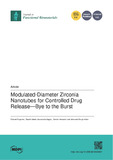Zitierlink:
https://doi.org/10.3390/jfb16020037Dateien zu dieser Ressource:
| Datei | Beschreibung | Größe | Format | |
|---|---|---|---|---|
| Modulated_diameter_zirconia_nanotubes.pdf | 2.35 MB | Adobe PDF |  Öffnen/Anzeigen |
| Dokumentart: | Article | Titel: | Modulated-diameter zirconia nanotubes for controlled drug release - bye to the burst | AutorInn(en): | Onyenso, Gabriel Vakamulla Raghu, Swathi Naidu Hartwich, Patrick Killian, Manuela |
Institut: | Department Chemie - Biologie | Schlagwörter: | Oxide nanostructures, Zirconia, Controlled release drug delivery, Anodization, Oxidische Nanostrukturen, Zirkoniumdioxid, Kontrollierte Wirkstoffabgabe, Anodisierung | DDC-Sachgruppe: | 540 Chemie | Erscheinungsjahr: | 2025 | Publikationsjahr: | 2025 | Auch erschienen: | Journal of Functional Biomaterials ; 16 (2), 37. - https://doi.org/10.3390/jfb16020037 | Zusammenfassung: | The performance of an orthopedic procedure depends on several tandem functionalities. Such characteristics include materials’ surface properties and subsequent responses. Implant surfaces are typically roughened; this roughness can further be optimized to a specific morphology such as nanotubular roughness (ZrNTs) and the surfaces can further be used as static drug reservoirs. ZrNTs coatings are attracting interest due to their potential to improve the success rate of implant systems, by means of better physical affixation and also micro/nano physio-chemical interaction with the extracellular matrix(ECM). Effective control over the drug release properties from such coatings has been the subject of several published reports. In this study, a novel and simple approach to extending drug release time and limiting the undesirable burst release from zirconia nanotubes (ZrNTs) via structural modification was demonstrated. The latter involved fabricating a double-layered structure with a modulated diameter and was achieved by varying the voltage and time during electrochemical anodization. The structurally modified ZrNTs and their homogenous equivalents were characterized via SEM and ToF-SIMS, and their drug release properties were monitored and compared using UV–Vis spectroscopy. We report a significant reduction in the initial burst release phenomenon and enhanced overall release time. The simple structural modification of ZrNTs can successfully enhance drug release performance, allowing for flexibility in designing drug delivery coatings for specific implant challenges, and offering a new horizon for smart biomaterials based on metaloxide nanostructures. |
Beschreibung: | Finanziert aus dem DFG-geförderten Open-Access-Publikationsfonds der Universität Siegen für Zeitschriftenartikel |
DOI: | https://doi.org/10.3390/jfb16020037 | URN: | urn:nbn:de:hbz:467-28574 | URI: | https://dspace.ub.uni-siegen.de/handle/ubsi/2857 | Lizenz: | http://creativecommons.org/licenses/by-nd/4.0/ |
| Enthalten in den Sammlungen: | Geförderte Open-Access-Publikationen |
Diese Ressource ist urheberrechtlich geschützt. |
Seitenansichten
37
checked on 05.02.2025
Download(s)
3
checked on 05.02.2025
Google ScholarTM
Prüfe
Prüfe
Diese Ressource wurde unter folgender Copyright-Bestimmung veröffentlicht: Lizenz von Creative Commons


